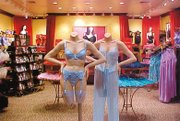Making Changes at a Lingerie Legend
At times, it’s hard to remember that 57-year-old Frederick’s of Hollywood is slogging through a bankruptcy. Known for its revealing lingerie, the Los Angeles-based manufacturer and retailer is getting its own fair share of exposure since filing Chapter 11 nearly two years ago under the leadership of its chief executive officer, Linda LoRe, who joined Frederick’s in 1999 after a successful run at Procter & Gamble–owned Giorgio Beverly Hills as president and CEO.
Changing the way Frederick’s does business, LoRe has spearheaded store renovations, merchandise updates and—a first for the company—the launch of an advertising campaign. Another strategy has involved partnerships and fashion shows with such radio stations as Los Angeles-based Star 98.7 (KYSR-FM) and the company’s upcoming Los Angeles Fashion Week party on April 11.
To streamline operations, the company has closed 25 stores since it filed for bankruptcy, leaving it with a total of 175. Frederick’s will roll out its new store design to 15 existing stores this year as well as five new ones, including locations at Ontario Mills in Ontario, Calif., and Great Lakes Crossing in Auburn Hills, Mich. Next year, the company will remodel 22 stores, including its headquarters store in Hollywood, and open 10 new stores.
According to bankruptcy attorney Michael Tuchin, the moves are all shaping up to bring Frederick’s out of bankruptcy by fall, a process set back by last year’s terrorist attacks. “We had hoped to be out sooner, but quite frankly, 9/11 severely delayed our progress,” Tuchin said. “Investors were reluctant to proceed. In the meantime, we had an extraordinary holiday season so we’ll benefit from the delay.”
Recently, California Apparel News retail editor Nola Sarkisian-Miller had a chance to talk with LoRe about the changes at Frederick’s.
Are there any new developments regarding the company bankruptcy? A year ago, the company said it was looking for a buyer.
We’re in the thick of the process, identifying an investor, the strategy, plan of reorganization, etc. We’re seeking investors, which is public knowledge, but I can’t comment on much more than that. I can say we’re turning the company around, and it’s looking the best as it’s looked. Our merchandise look has changed, our store look has changed, and our advertising strategy—where there was none—has changed.
About a year after you began working at Frederick’s, the company declared bankruptcy. How have you managed through the cumbersome process?
It’s a very arduous task doing bankruptcy. You have to do what you do in a company and then some. You’re learning new laws and it takes a dedicated team. When I was hired, I was hired to do a turnaround of the company. At that time, we didn’t realize it was a bankruptcy turnaround. At the time, they brought me in as an expert in retail and fashion to reposition the company, and what I found was a totally different need.
You opened a new prototype store last fall at the Boulevard Mall in Las Vegas and last month at Glendale Galleria [in Glendale, Calif.]. How has the store look changed?
The goal was to update the store, to become more approachable, more welcoming, I think, from the point of view of making people not afraid to come into a Frederick’s of Hollywood. No advertising for stores has been done—until this past year. So, people who knew anything about Frederick’s only knew what they had heard from someone or from our catalog. A lot of people had no real idea what we had in stores. That was our goal—to put [out] a small, boutique-type prototype [ranging from 1,800 to 2,400 square feet] to really welcome people to enjoy the shopping experience and not be intimidated. People had the wrong perception. People perceived we were more racy than we were. The older stores had different lighting; they were more garish; the colors were brighter. We’ve created a softer, more welcoming environment, with leopard-print carpeting, tan walls, red curtains. It’s fun, but there’s a boudoir feeling. It takes you back to the drama, fun and glamour of Hollywood. And, since California is a target market for us, we plan on starting our remodeling here. In Southern California, we have 25 stores and we intend to redo about half of them by August.
What led to the decision to partner Frederick’s with Los Angeles Fashion Week this month?
We’ve decided as a major manufacturer on the West Coast, we’ve never had a presence [at Fashion Week]. It seems to be gaining greater traction, so we thought we ought to have a major presence at it. We’re kicking off Fashion Week at Star Shoes in Hollywood on Thursday, April 11 with our fashion show and party, where we’ll preview our Fall merchandise—we’ve never done that here in California before. We want to make this part of our statement of our emerging strategy, kind of like our coming-out party.
How do you view Frederick’s among the competition?
Right now, the only competition we have in terms of specialty retail for intimate apparel is Victoria’s Secret—who are light years ahead of us. Frederick’s let the market be completely captured by really not doing much while Victoria’s Secret was growing. But, Victoria’s Secret also did a lot for the intimate-apparel industry by making mainstream shopping for intimate apparel an everyday occurrence. Victoria’s Secret is the biggest and we’re No. 2 and we’re considerably smaller. We have 175 stores and they have 1,000. They present a different point of view. Their stores are larger; ours are smaller, with more of a boutique feel. We sell red and they sell pink. We focus on sexy and they focus on pretty. That doesn’t mean we don’t focus on pretty. It’s just what order you put them in. We don’t sell flannel and they do. Both of us sell cotton, but they sell a lot of cotton and we sell sexy cotton. They’re less [like French lingerie label] Agent Provocateur; we’re more like Agent Provocateur.
You sell in stores, on the Internet and through catalogs. How are the different sales channels working?
To date, 60 percent of our business comes from the stores and 40 percent is done direct through our catalogs and the Internet. The total [sales] volume at our stores is less with our store closures, but the Internet business has grown significantly. The stores that are open, as well as the new stores, are doing very well. You take all that into consideration, we’re doing about $150 million or so worth of business. It’s still broken down with the Internet doing more business than catalog because that’s the paradigm shift in direct marketing. Our catalog business is driving Internet sales, but the whole pie is growing in total for us.























